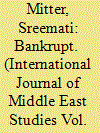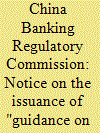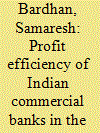|
|
|
Sort Order |
|
|
|
Items / Page
|
|
|
|
|
|
|
| Srl | Item |
| 1 |
ID:
101096


|
|
|
|
|
| Publication |
2010.
|
| Summary/Abstract |
The paper seeks to examine the determinants of Indonesian banks profitability during the period 19902005. The empirical findings indicate that income diversification and capitalization are positively related to bank profitability, while size and overhead costs exert negative impacts. During the period under study, Indonesian banks seem to have been skimping on their resources, particularly during the pre-crisis and crisis periods. The impact of economic growth and banking sector concentration are positive during the pre-crisis and crisis periods. We find that the Asian financial crisis exerts negative and significant impact on the profitability of Indonesian banks, while Indonesian banks have been relatively more profitable during the pre-crisis compared to the post-crisis and crisis periods.
|
|
|
|
|
|
|
|
|
|
|
|
|
|
|
|
| 2 |
ID:
170358


|
|
|
|
|
| Summary/Abstract |
This study aims at measuring the technical efficiency of banks in India and examining its determinants. Efficiency is said to be achieved if a bank is able to maximise its output subject to limited inputs. To obtain technical efficiency score, input-oriented Malmquist Data Envelopment Analysis is applied on two outputs and three input variables, based on a VRS (variable returns to scale) assumption. Three foreign banks—namely, A B Bank Ltd, Bank of Ceylon, and Citibank N A—and two Indian banks—namely, HDFC Bank and State Bank of India—are found to be most efficient during the study period. The efficiency scores when subsequently used as the dependent variable along with independent variables—bank size, capitalisation, liquidity risk, returns on assets, interest rate, credit risk, market concentration and gross domestic product (GDP)—in a panel regression analysis found the fixed effect model to be more appropriate in explaining the determinants. The results reveal that liquidity risk, returns on assets, credit risk, market concentration and GDP have a significant effect on the technical efficiency, while banks size, interest rate and level of capitalisation are found to be insignificant variables.
|
|
|
|
|
|
|
|
|
|
|
|
|
|
|
|
| 3 |
ID:
172453


|
|
|
|
|
| Summary/Abstract |
In the late 1930s, the first independent Arab banks in Palestine, the Arab Bank and the Arab Agricultural Bank, sued customers who had defaulted on loans in an attempt to maintain solvency. Their indebted customers, unable to pay, fought back to prevent their lands from being foreclosed and sold to Zionist buyers. Each party claimed that its position was consistent with, indeed essential to, the anti-Zionist nationalist cause. The story of these pioneering Arab banks and their legal battles with their customers in the wake of the 1936-1939 revolt provides insight into Arab financial life in Mandate Palestine. It reveals the banks’ struggles to survive; complicates notions of Arab-Palestinian landlessness and indebtedness; and argues that political and economic exigencies, not reductive notions of collaboration or patriotism, produced the banks’ antagonistic relationship with their customers, whereby the survival of one came at the expense of the other.
|
|
|
|
|
|
|
|
|
|
|
|
|
|
|
|
| 4 |
ID:
101086


|
|
|
|
|
| Publication |
2010.
|
| Summary/Abstract |
This paper examines the efficiency of the Thai banking sector from 1999 to 2008 by using the data envelopment analysis (DEA) method. The results indicate that inefficiency in the sector stems mainly from scale rather than pure technical efficiencies. The findings suggest that small banks are most efficient, while medium-sized banks have been the least efficient banking group. Domestic banks have been relatively more efficient than their foreign bank peers, which can be attributed largely to a higher pure technical efficiency (PTE) level. The results from the multivariate regression analysis suggest that banks with higher loans intensity and which are relatively better capitalised tend to exhibit higher efficiency levels. On the other hand, credit risk is negatively related to bank efficiency. The empirical findings suggest that the recent global financial crisis exerts a negative impact on the efficiency of Thai banks.
|
|
|
|
|
|
|
|
|
|
|
|
|
|
|
|
| 5 |
ID:
161488


|
|
|
|
|
| Summary/Abstract |
The study examines factors influencing non-performing loans (NPLs) for Indian banks. The analysis contributes by including restructured advances also in addition to standard measures of asset quality that provides comprehensive picture of pressure on banks’ balance sheet. Moreover, Bayesian technique with multivariate t-distributed prior is applied for robust estimation. Utilizing quarterly dataset from 2005 to 2015, strong persistence of bad assets is clearly evident. Bank-specific characteristics such as growth of advances, profitability and net interest margin are significant determinants. Among macro-factors, high growth rate is having retarding impact on bad assets. Moreover, ownership effect is having differential behaviour with state-owned banks being most vulnerable.
|
|
|
|
|
|
|
|
|
|
|
|
|
|
|
|
| 6 |
ID:
136065


|
|
|
|
|
| Summary/Abstract |
Net interest margin (NIM) is an indicator of the level of efficiency of financial intermediation by banks. This study analyses the determinants of NIMs of domestic banks of Sri Lanka for the period of January 2002 to March 2011 based on the model developed by Ho and Saunders and its extensions using panel regression. Sri Lankan banks are inward looking in setting NIMs as operating costs, credit risk, risk aversion, non-interest income and capital adequacy requirements are determinants. Market competition, other regulations on banks, risk arising from the volatility of market prices and macroeconomic variables do not have a significant impact on the determination of NIMs.
|
|
|
|
|
|
|
|
|
|
|
|
|
|
|
|
| 7 |
ID:
053916


|
|
|
|
|
| Publication |
Sep-Oct 2004.
|
|
|
|
|
|
|
|
|
|
|
|
|
|
|
|
| 8 |
ID:
096641


|
|
|
|
|
| Publication |
2010.
|
| Summary/Abstract |
In the mid-1990s there was a sudden renewed public interest in the issue of looted Jewish possessions during the war and their very partial restitution afterward. In the Netherlands, public interest in restitution issues gradually reemerged after several decades of almost total silence. In the late 1990s, public inquiries focused on the government, banks, insurers, and the Amsterdam Stock Exchange. At the turn of the twentieth century, the Amsterdam Stock Exchange was controlled by the major Dutch banks. The restitution negotiations between the Jewish umbrella-body CJO and the exchange therefore became part of those with the Dutch Banking Association (NVB). After exceedingly low financial proposals by the exchange, the representatives of Dutch Jewry in the Netherlands and Israel involved the World Jewish Congress (WJC) in the negotiations. The WJC in turn approached the Hevesi Committee of American comptrollers. Seeing the American business of their members threatened, the NVB agreed to increase the offered payment more than thirtyfold.
|
|
|
|
|
|
|
|
|
|
|
|
|
|
|
|
| 9 |
ID:
158860


|
|
|
|
|
| Summary/Abstract |
On October 17, 2008, during the throes of the global financial crisis, officials from the U.S. Department of Justice summoned Swiss banking regulators and executives from UBS, Switzerland’s largest bank, to a closed-door meeting in New York to discuss the bank’s role in helping American clients evade taxes. It was a sensitive moment: the Swiss government had bailed out UBS the previous day. The bank’s game plan was simple, a company insider later told Reuters [3]: “Admit guilt, settle the case quickly, and move on.”
|
|
|
|
|
|
|
|
|
|
|
|
|
|
|
|
| 10 |
ID:
120081


|
|
|
|
|
| Publication |
2012.
|
| Summary/Abstract |
The study presents an early warning system for predicting banking fragility in India. Using the index method, distress episodes in the banking system are identified during 1994-2007. On the basis of standard tools of probit regression models, the results indicate growing interlinkages of economic liberalization with the Indian banking sector. Slowdown in real output, increase in headline inflation rate, increase in spread between the central bank policy rate and short-term risk-free rate, increase in proportion of broad money supply to foreign exchange reserves, REER overvaluation from trend and decrease in proportion of trade balance to GDP enhance the probability of banking fragility in India. The behaviour of the identified crucial indicators, cross-checked by the signal extraction approach, reveals adequate signalling power due to their low Noise-to-Signal Ratio. The estimated 'lead time' of the indicator variables in signalling banking distress also offers a modest time period to the government to initiate pre-emptive policy action to strengthen the banks.
|
|
|
|
|
|
|
|
|
|
|
|
|
|
|
|
| 11 |
ID:
155675


|
|
|
|
|
| Summary/Abstract |
This study examines how various bank groups operating in India have fared macro stress events and conduct macro stress testing (MST) to trace the impact of certain macroeconomic stress scenarios on the credit quality of five Indian bank groups, that is, the State Bank of India (SBI) and its associates (SBGs), nationalised banks (NBs), old private sector banks (OPBs), new private sector banks (NPBs) and foreign banks (FBs), using panel data from 1997 to 2014.
|
|
|
|
|
|
|
|
|
|
|
|
|
|
|
|
| 12 |
ID:
139481


|
|
|
|
|
| Summary/Abstract |
In recent years, there has been an increase in multiple borrowing in the microfinance sector in Sri Lanka, while many microfinance institutions (MFIs) have experienced high levels of borrower turnover, deteriorating portfolio quality and weak financial performance. This has raised concerns about the microfinance sector. However, the debt levels for the majority of borrowers remain at moderate levels, while a number of mitigating factors such as mobilization of borrower savings by MFIs, wide use of pawning among clients and a reduction in donor funds to the sector suggest that a microcredit bubble in Sri Lanka is unlikely in the near future.
|
|
|
|
|
|
|
|
|
|
|
|
|
|
|
|
| 13 |
ID:
102691


|
|
|
| 14 |
ID:
099392


|
|
|
|
|
| Publication |
Washington, DC, World Bank, 2010.
|
| Description |
xviii, 103p.
|
| Standard Number |
9780821382493
|
|
|
|
|
|
|
|
|
|
|
|
Copies: C:1/I:0,R:0,Q:0
Circulation
| Accession# | Call# | Current Location | Status | Policy | Location |
| 055306 | 332.42/GRE 055306 | Main | On Shelf | General | |
|
|
|
|
| 15 |
ID:
091308


|
|
|
|
|
| Publication |
Washington, DC, World Bank, 2009.
|
| Description |
xxvii, 271p.
|
| Standard Number |
9780821379127
|
|
|
|
|
|
|
|
|
|
|
|
Copies: C:1/I:0,R:0,Q:0
Circulation
| Accession# | Call# | Current Location | Status | Policy | Location |
| 054399 | 364.168/CHA 054399 | Main | On Shelf | General | |
|
|
|
|
| 16 |
ID:
123865


|
|
|
|
|
| Publication |
2013.
|
| Summary/Abstract |
This article estimates bank-specific profit efficiency of three broad ownership groups of Indian banks during the period 1995-96 to 2011-12, using the stochastic frontier methodology. Results reveal that during the post-liberalisation period, public sector banks in India are the best performers in terms of estimated profit efficiency. Further, foreign banks operating in India record higher profit efficiency levels compared to domestic private banks. The introduction of prudential regulations, such as capital adequacy ratios, has had a significant positive impact on the profit efficiency of Indian banks, while loan defaults adversely affect their profit efficiency. Market power does not necessarily lead to an increase in profit efficiency, while bank mergers have had a significant positive effect. Contrary to the expectation that the Indian banking system is highly resilient and sufficiently robust to cope with external shocks, the results reveal that the ongoing global financial crisis has had a significant adverse effect on the profit efficiency of Indian banks.
|
|
|
|
|
|
|
|
|
|
|
|
|
|
|
|
| 17 |
ID:
105943


|
|
|
|
|
| Publication |
2011.
|
| Summary/Abstract |
The implementation of the ongoing anti-money laundering/counter-terrorism financing (AML/CTF) drive within the private sector reflects a tension between the logic of state sovereignty and that of neoliberal governmentality. In this article, we show that the main concrete output of two decades of global policy in this area is found in the routinization of professional interactions between banks and law enforcement agencies. Banks recruit former law enforcement officials and attempt to establish informal ties with the police or intelligence bodies. They are also actively involved in intelligence-led policing missions and have become embedded in interdependent relationships with law enforcement agencies. Drawing on data from 75 interviews conducted with AML/CTF professionals within France, the article shows how new everyday professional routines in the banking sector reflect governmentality in the making.
|
|
|
|
|
|
|
|
|
|
|
|
|
|
|
|
| 18 |
ID:
120067


|
|
|
|
|
| Publication |
2013.
|
| Summary/Abstract |
Since 2009, analyses of Iran have stressed the centralizing takeover of the country's economy by a single state institution, the Islamic Revolutionary Guards Corps. At the same time, however, Iran's factionalized political elite uniformly advocate for rapid privatization of state-owned enterprises. Underneath this puzzling contradiction is a complex shift of economic ownership away from the state toward a variety of parastatal organizations including banks, cooperatives, pension funds, foundations, and military-linked contractors. The result is not a praetorian monolith but a subcontractor state. This article draws on interviews conducted in Iran during 2009 and 2010, primary data from parliamentary and governmental reports, and secondary sources to show how intraelite conflict and nonelite claims have structured the process of privatization. Framed comparatively with privatization outcomes in other middle-income countries, Iran's subcontractor state can be seen as a consequence of the way in which politics and society shaped the form of capitalism that has taken root in the Islamic Republic.
|
|
|
|
|
|
|
|
|
|
|
|
|
|
|
|
| 19 |
ID:
163300


|
|
|
|
|
| Summary/Abstract |
Some recent articles have studied the link between the central bank’s monetary policy stance and the risk-taking behaviour of banks in the context of advanced economies. Loose monetary policy can encourage banks to reach for yield, which will increase their share of risky assets, and also induce them to use more short-term funding. We empirically examine the existence of this risk-taking channel of monetary policy transmission in India. We find that expansionary monetary policy may increase default risk particularly for foreign banks and new private sector banks. We also find that tightening of monetary policy leads to lower liquidity risk and market risk and the effects are stronger for foreign banks than for other bank groups. In terms of market risk, the effect on foreign banks is weaker in cases of monetary tightening compared to expansion.
|
|
|
|
|
|
|
|
|
|
|
|
|
|
|
|
| 20 |
ID:
073966


|
|
|
|
|
| Publication |
2006.
|
| Summary/Abstract |
Banks depending on their ownership type may demonstrate different responses to the changing operational environment. The Turkish financial system has undergone significant legal, structural and operational changes as a result of financial liberalization launched in the early 1980s. This paper investigates the sources of initial productivity changes in public, private and foreign banks as financial repression is phased out of the Turkish financial system. According to the non?parametric Malmquist indexes, the results show that publicly owned banks realized the slowest productivity growth and foreign banks experienced the fastest after liberalization. Most of the productivity growth at public banks has come from changing scale, while private (domestic or foreign) banks have seen more productivity growth from increasing technical efficiency. Apparently, the productivity growth observed in Turkish banks during the liberal period mostly results from banks coming closer to the existing technological frontier (increased efficiency). However, the progress of the technological frontier during the period, representing the most efficient deployment of resources possible, was not as impressive. This implies that the source of productivity growth in Turkish banks is mainly "imitation"-the efforts of the inefficient banks to catch up with the best?practice banks-rather than "innovation"-the outward shifts of the production frontier by leading banks.
|
|
|
|
|
|
|
|
|
|
|
|
|
|
|
|
|
|
|
|
|